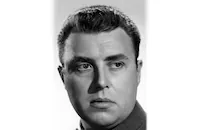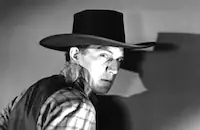Valley of the Sun

Brief Synopsis
Cast & Crew
George Marshall
Lucille Ball
James Craig
Sir Cedric Hardwicke
Dean Jagger
Peter Whitney
Film Details
Technical Specs

Synopsis
In 1868, in Arizona, frontier scout Jonathan Ware is court-martialed for allowing three innocent Indians to escape from an Army jail. After Jonathan is sentenced to a five-year prison term, a friendly sergeant who understands the scout's concern for the injustices suffered by the Indians allows him to escape. Jonathan then hitches a ride on a stagecoach carrying Indian agent Jim Sawyer and a justice of the peace, who is accompanying the agent to the town of Desert Center to marry Sawyer and Christine Larson, the proprietor of the Busy Bee Café. When Sawyer discovers his non-paying passenger, he throws Jonathan off the stage, and the scout hitches a ride to town with an Indian. At the Busy Bee Café, Chris is awaiting the arrival of the coach when Willie, her simple-minded but kindhearted friend, warns her that Sawyer doesn't love her. Willie's instincts are correct, for in reality, Sawyer is a dishonorable man who has been cheating the Indians of their cattle. After the stage arrives, Sawyer and Chris dress for the wedding ceremony. Attired in his wedding finery, Sawyer goes to the café, and when he finds Jonathan there, a fistfight erupts in which the bridegroom is soundly beaten. Warrick, an English settler who detests the corrupt Sawyer, offers Jonathan refuge at his house, but when Sawyer's men track the scout there, they beat him up and throw him out of town. Finding Jonathan unconscious in the desert, Willie takes him to Chris for medical aid. Jonathan is attracted to Chris, and upon recovering, he joins forces with Willie and Warrick to stop the wedding. Crawling into the attic above the chapel, the three drop red ants on the bridegroom until he runs, scratching, out of the chapel. When Willie abducts the judge to prevent the wedding, Chris and Sawyer take the stage to Tucson, where they plan to marry. Along the trail, Jonathan, who has decided to travel to Washington to plead the case of the Indian, and the judge board the stage. With the judge on board, Chris and Sawyer decide to marry in the coach, but their nuptials are interrupted by an Indian attack. Recognizing his friend Jonathan, Chief Cochise takes the four passengers to his camp, where a meeting of the tribes is being held. To protect Chris, Jonathan tells the Indians that she is his wife. When Geronimo recognizes Sawyer as the man who has been stealing cattle from the Indians, he demands his life. After promising to return the cattle, Jonathan challenges Geronimo to a contest for Sawyer's life. When Jonathan wins the contest, the Indians set their four prisoners free, and while riding along a mountain trail, they see several cavalry officers riding the trail below. Sawyer calls to the men, but by the time the soldiers arrive, Jonathan has disappeared and Lieutenant Burke informs them that there is a bounty on the scout. Back in town, Chris, who has fallen in love with Jonathan, calls off her wedding. When a jealous Sawyer discovers Jonathan visiting Chris at the café, he calls the soldiers to arrest the scout. Soon after, Cochise visits Sawyer to demand the return of the cattle, but the agent reneges on his promise and takes Cochise prisoner instead. That night, Jonathan and his captors are camped along the trail when Chris, Willie, the judge and Warrick surprise his guards and free him. Determined to make Sawyer keep his word, Jonathan threatens to turn him over to the Indians unless he returns the cattle. As they are driving the herd toward the Indian camp, Jonathan sees war smoke signals and Sawyer admits to holding Cochise prisoner. The Indian war party is converging on the town just as Jonathan and Sawyer gallop in and free Cochise, halting the attack. After witnessing Jonathan's good deeds, the lieutenant lets him go free. Jonathan and Chris then marry and are bound for their honeymoon via stagecoach when Sawyer, in a hurry to leave the state, boards the coach. After knocking the intruder unconscious, Jonathan kisses his bride.

Director

George Marshall
Cast

Lucille Ball

James Craig

Sir Cedric Hardwicke

Dean Jagger

Peter Whitney

Billy Gilbert

Tom Tyler

Antonio Moreno
George Cleveland
Hank Bell
Richard Fiske
Don Terry
Chris Willow Bird

Fern Emmett
Carleton Young
Carl Sepulveda
George Melford
Pat Moriarty
Stanley Andrews
Chester Clute
Al St. John
Harry Lamont
Al Ferguson

Chester Conklin
Ed Brady

Lloyd Ingraham
Frank Coleman
Ethan Laidlaw
Steve Clemento
George Lloyd
Bud Osborne
Tom London
Francis Mcdonald
Harry Hayden
Crew
C. Bakaleinikoff
Graham Baker
Albert S. D'agostino
Edward Donahue
Bailey Fesler
John C. Grubb
Walter E. Keller
Desmond Marquette
Horace Mccoy
Paul Sawtell
Edward Stevenson
Vernon L. Walker
Harry Wild

Film Details
Technical Specs

Articles
Valley of the Sun
RKO had fallen on hard times by the early '40s. The studio that had brought Katharine Hepburn and Orson Welles to Hollywood and had given the world such classics as King Kong (1933) and the Fred Astaire-Ginger Rogers movies was in financial difficulties, partly because of the losses generated by Welles' first two films, Citizen Kane (1941) and The Magnificent Ambersons (1942). Artistically inclined studio head George Schaeffer, the man who had brought Welles to Hollywood, was out. In his place was Peter Rathvon, whose bottom-line approach to production dictated a schedule of mostly genre programmers.
The studio's management had never been that well-disposed toward Ball, but they had kept her on, largely through the urging of acting coach Lela Rogers (mother of Ginger) and a few influential producers and directors. After a raft of public opinion polls, management decided that the expensive star ($3,500 a week) had little public image. She even made the short list in a poll of film personalities deemed least likely to become stars (among the names were such future stars as Ann Miller, Victor Mature and William Holden!). The one plus she had was popularity with younger fans.
That may have inspired the powers that be to try her out in a Western, a genre that had made a lot of money for the studio in the past and with proven popularity among younger moviegoers. For material they turned to a Saturday Evening Post serial by Clarence Budington Kelland, best known as author of the story "Opera Hat," on which Mr. Deeds Goes to Town (1936) had been based. The studio also gave her a promising leading man, James Craig, who had just scored hits in the Ginger Rogers romance Kitty Foyle (1940) and the fantasy All That Money Can Buy (1941). They also brought in Western expert George Marshall to direct. He had recently helped Marlene Dietrich make a comeback as a saloon singer in Destry Rides Again (1939), though he wouldn't quite work the same magic with Ball.
The biggest problem was meager production values. RKO advertised the film as a Western epic in the tradition of Cimarron (1931), the studio's only film to win a Best Picture Oscar®, but then didn't supply the epic qualities. Critics mostly complained of trite situations and hackneyed lines, while also suggesting that Ball and Craig lacked marquee value.
On the plus side, location shooting in Taos, New Mexico, gave Ball a second honeymoon with husband Desi Arnaz, even though it meant shooting in blistering heat. On her off days, they explored the nearby reservations. The location also gave the production access to a large contingent of authentic Native American extras from the pueblos in Taos, Santa Clara, Jemes, San Juan and Tesuque. Fans also have pointed to outstanding supporting performances by the screen's Captain Marvel, Tom Tyler, and silent star Antonio Moreno as Geronimo and Cochise, respectively.
The film's poor critical showing did little to help Ball's career, particularly when follow-up polls indicated that it had only brought her popularity and recognition up a few points. Craig, however, profited from his exposure in the male lead. He had come to Hollywood hoping to exploit his resemblance to Clark Gable and had even tested with some of the actresses considered for the role of Scarlett in Gone with the Wind (1939). But it had taken many fruitless years at Paramount and a few decent roles at RKO to bring him to the attention of Gable's home studio, MGM. After his work in Valley of the Sun, MGM put him under contract as a threat to the bigger star and a useful leading man while stars like Gable were off fighting World War II.
Ball maintained a friendly relationship with Marshall, who would later cast her in the Western comedy Fancy Pants (1950), opposite Bob Hope. Years later she would hire him to direct for her TV series Here's Lucy, though he would only get through a dozen episodes before her temperament, aggravated by poor reviews and a lack of network support, led him to leave. Before his departure, he even took to wearing a hard hat on the set, quipping that he needed it for protection from the star.
Producer: Graham Baker
Director: George Marshall
Screenplay: Horace McCoy
Based on the story by Clarence Budington Kelland
Cinematography: Harry Wild
Art Direction: Albert S. D'Agostino, Walter E. Keller
Music: Peter Sawtell
Cast: Lucille Ball (Christine Larson), James Craig (Jonathan Ware), Cedric Hardwicke (Warrick), Dean Jagger (Jim Sawyer), Billy Gilbert (Justice of the Peace), Tom Tyler (Geronimo), Antonio Moreno (Chief Cochise), George Cleveland (Bill Yard), Al St. John, Chester Conklin (Men in the Street).
BW-78m.
by Frank Miller

Valley of the Sun
Quotes
There's only two ways to handle women...and nobody knows what they are.- Bill Yard
Trivia
Notes
According to a 1940 news item in Hollywood Reporter, Robert Sisk was originally slated to produce this film, Bartlett Cormack was to have written the screenplay and Joel McCrea was to play the male lead. A July 1941 news item in Hollywood Reporter notes that Dorothy Comingore was slated as the female lead, but illness forced her replacement by Lucille Ball. Another pre-production news item in Hollywood Reporter adds that soundman Bailey Fesler was transferred from this film to The Magnificent Ambersons at the request of Orson Welles. According to the Hollywood Reporter review, the film was shot on location in Arizona and in Santa Fe and Taos, NM, and employed Indians from the Taos, Santa Clara, Jemes, San Juan and Tesuque pueblos in New Mexico. Another news item in Hollywood Reporter adds that actor Tom Tyler was borrowed from Republic to appear in this film.















